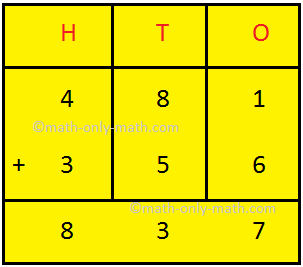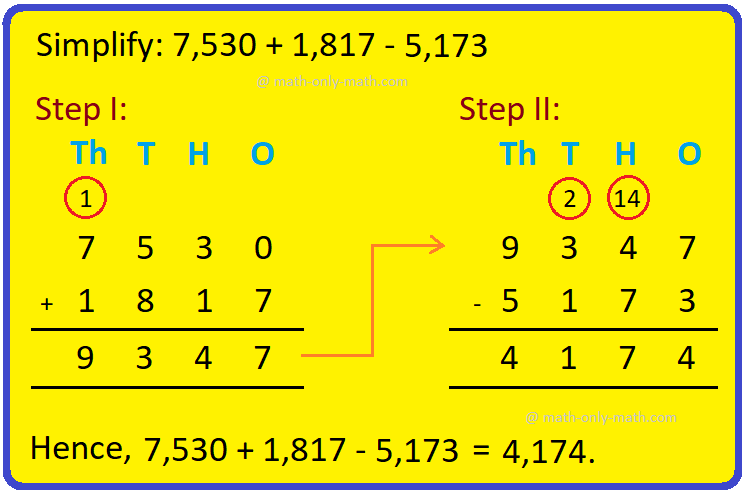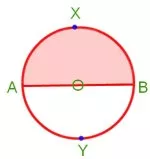Learn math step-by-step.
Subscribe to our YouTube channel for the latest videos, updates, and tips.
Home | About Us | Contact Us | Privacy | Math Blog
Solved Examples on Exponents
Here are some solved examples on exponents using the laws of exponents.
1. Evaluate the exponent:
(ii) (1/3)-4
(iii) (5/2)-3
(iv) (-2)-5
(v) (-3/4)-4
We have:
(i) 5-3 = 1/53 = 1/125
(ii) (1/3)-4 = (3/1)4 = 34 = 81
(iii) (5/2)-3 = (2/5)3 = 23/53 = 8/125
(iv) (-2)-5 = 1/(-2)-5 = 1/-25 = 1/-32 = -1/32
(v) (-3/4)-4 = (4/-3)4 = (-4/3)4 = (-4)4/34 = 44/34 = 256/81
2. Evaluate: (-2/7)-4 × (-5/7)2
Solution:
(-2/7)-4 × (-5/7)2
= (7/-2)4 × (-5/7)2
= (-7/2)4 × (-5/7)2 [Since, (7/-2) = (-7/2)]
= (-7)4/24 × (-5)2/72
= {74 × (-5)2}/{24 × 72 } [Since, (-7)4 = 74]
= {72 × (-5)2 }/24
= [49 × (-5) × (-5)]/16
= 1225/16
3. Evaluate: (-1/4)-3 × (-1/4)-2
Solution:
(-1/4)-3 × (-1/4)-2
= (4/-1)3 × (4/-1)2
= (-4)3 × (-4)2
= (-4)(3 + 2)
= (-4)5
= -45
= -1024.
4. Evaluate: {[(-3)/2]2}-3
Solution:
{[(-3)/2]2}-3
= (-3/2)2 × (-3)
= (-3/2)-6
= (2/-3)6
= (-2/3)6
= (-2)6/36
= 26/36
= 64/729
5. Simplify:
(i) (2-1 × 5-1)-1 ÷ 4-1
(ii) (4-1 + 8-1) ÷ (2/3)-1
Solution:
(i) (2-1 × 5-1)-1 ÷ 4-1
= (1/2 × 1/5)-1 ÷ (4/1)-1
= (1/10)-1 ÷ (1/4)
= 10/1 ÷ 1/4
= (10 ÷ 1/4)
= (10 × 4)
= 40.
(ii) (4-1 + 8-1) ÷ (2/3)-1
= (1/4 + 1/8) ÷ (3/2)
= (2 + 1)/8 ÷ 3/2
= (3/8 ÷ 3/2)
= (3/8 ÷ 2/3)
= 1/4
6. Simplify: (1/2)-2 + (1/3)-2 + (1/4)-2
Solution:
(1/2)-2 + (1/3)-2 + (1/4)-2
= (2/1)2 + (3/1)2 + (4/1)2
= (22 + 32 + 42)
= (4 + 9 + 16)
= 29.
7. By what number should (1/2)-1 be multiplied so that the product is (-5/4)-1?
Solution:
Let the required number be x. Then,
x × (1/2)-1 = (-5/4)-1
⇒ x × (2/1) = (4/-5)
⇒ 2x = -4/5
⇒ x = (1/2 × -4/5) = -2/5
Hence, the required number is -2/5.
8. By what number should (-3/2)-3 be divided so that the quotient is (9/4)-2?
Solution:
Let the required number be x. Then,
(-3/2)-3/x = (9/4)-2
⇒ (-2/3)3 = (4/9)2 × x
⇒ (-2)3/33 = 42/92 × x
⇒ -8/27 = 16/81 × x
⇒ x = {-8/27 × 81/16}
⇒ x = -3/2
Hence, the required number is -3/2
9. If a = (2/5)2 ÷ (9/5)0 find the value of a-3.
Solution:
a-3 = [(2/5)2 ÷ (9/5)0]-3
= [(2/5)2 ÷ 1]-3
= [(2/5)2]-3
= (2/5)-6
= (5/2)6
10. Find the value of n, when 3-7 ×32n + 3 = 311 ÷ 35
Solution:
32n + 3 = 311 ÷ 35/3-7
⇒ 32n + 3 = 311 - 5/3-7
⇒ 32n + 3 = 36/3-7
⇒ 32n + 3 = 36 - (-7)
⇒ 32n + 3 = 36 + 7
⇒ 32n + 3 = 313
Since the bases are same and equating the powers, we get 2n + 3 = 13
2n = 13 – 3
2n = 10
n = 10/2
Therefore, n = 5
11. Find the value of n, when (5/3)2n + 1 (5/3)5 = (5/3)n + 2
Solution:
(5/3)2n + 1 + 5 = (5/3)n + 2
= (5/3)2n + 6 = (5/3)n + 2
Since the bases are same and equating the powers, we get 2n + 6 = n + 2
2n – n = 2 – 6
=> n = -4
12. Find the value of n, when 3n = 243
Solution:
3n = 35
Since, the bases are same, so omitting the bases, and equating the powers we get, n = 5.
13. Find the value of n, when 271/n = 3
Solution:
(27) = 3n
⇒ (3)3 = 3n
Since, the bases are same and equating the powers, we get
⇒ n = 3
14. Find the value of n, when 3432/n = 49
Solution:
[(7)3]2/n = (7)2
⇒ (7)6/n = (7)2
⇒ 6/n = 2
Since, the bases are same and equating the powers, we get n =
● Exponents
Integral Exponents of a Rational Numbers
● Exponents - Worksheets
8th Grade Math Practice
From Solved Examples on Exponents to HOME PAGE
Didn't find what you were looking for? Or want to know more information about Math Only Math. Use this Google Search to find what you need.
Recent Articles
-
5th Grade Circle Worksheet | Free Worksheet with Answer |Practice Math
Jul 11, 25 02:14 PM
In 5th Grade Circle Worksheet you will get different types of questions on parts of a circle, relation between radius and diameter, interior of a circle, exterior of a circle and construction of circl… -
Construction of a Circle | Working Rules | Step-by-step Explanation |
Jul 09, 25 01:29 AM
Construction of a Circle when the length of its Radius is given. Working Rules | Step I: Open the compass such that its pointer be put on initial point (i.e. O) of ruler / scale and the pencil-end be… -
Combination of Addition and Subtraction | Mixed Addition & Subtraction
Jul 08, 25 02:32 PM
We will discuss here about the combination of addition and subtraction. The rules which can be used to solve the sums involving addition (+) and subtraction (-) together are: I: First add -
Addition & Subtraction Together |Combination of addition & subtraction
Jul 08, 25 02:23 PM
We will solve the different types of problems involving addition and subtraction together. To show the problem involving both addition and subtraction, we first group all the numbers with ‘+’ and… -
5th Grade Circle | Radius, Interior and Exterior of a Circle|Worksheet
Jul 08, 25 09:55 AM
A circle is the set of all those point in a plane whose distance from a fixed point remains constant. The fixed point is called the centre of the circle and the constant distance is known






New! Comments
Have your say about what you just read! Leave me a comment in the box below. Ask a Question or Answer a Question.